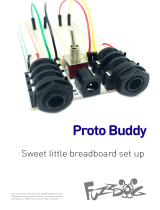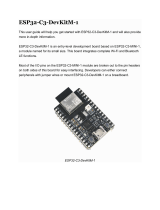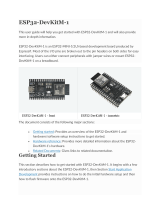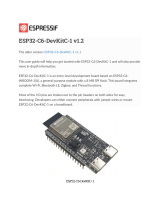Page is loading ...

instructables
Publishing Particulate Matter Sensor Data to Adafruit IO With Maker Pi Pico
and ESP-01S
by kevinjwalters
This article shows how to publish data from three low-cost particulate matter sensors to the Adafruit IO IoT service using
the Cytron Maker Pi Pico running a CircuitPython program transmitting the sensors' outputs over Wi-Fi with an ESP-01S
module running AT rmware.
The WHO identies PM2.5 particulate matter as one of the greatest environmental risks to health with 99% of the world's
population living in places where the WHO air quality guidelines levels were not met in 2019. It estimates 4.2 million
premature deaths were caused by this in 2016.
The three particulate matter sensors shown in this article are:
the Plantower PMS5003 using a serial connection;
the Sensirion SPS30 using i2c;
the Omron B5W LD0101 with pulse outputs.
These optical sensors are similar to the ones found in one type of domestic smoke alarm but they dier in their attempt
to count particles of dierent sizes rather than just alarm at a threshold concentration.
The red laser-based PMS5003 is a commonly used hobbyist sensor and can be found in the PurpleAir PA-II air quality
sensor. The SPS30 is a more recent sensor using the same principle and can be found in the Clarity Node-S air quality
sensor. The infrared LED-based B5W LD0101 sensor has a more primitive interface but is useful for its ability to detect
particles larger than 2.5 microns - the other two sensors cannot reliably measure these.
Adafruit IO oers a free tier with a limited number of feeds and dashboards - these are sucient for this project. The free
tier data is retained for 30 days but the data can easily be downloaded.
The Maker Pi Pico board in this article is a sample Cytron kindly sent to me to evaluate. The only dierence to the
production version is the addition of passive components to debounce the three buttons.
The ESP-01S module is likely to need an AT rmware upgrade. This is a relatively complex, ddly process and may be
time-consuming. Cytron sell the module with the appropriate AT rmware on it.
The Omron B5W LD0101 sensor is unfortunately being discontinued by the manufacturer with last orders in March
2022.
Supplies:
Cytron Maker Pi Pico - Digi-key | PiHut
ESP-01S - Cytron's board comes with appropriate AT rmware.
ESP-01 USB adapter/programmer with reset button - Cytron.
Breadboard.
Female to male jumper wires, maybe 20cm (8in) minimum length.
Publishing Particulate Matter Sensor Data to Adafruit IO With Maker Pi Pico and ESP-01S: Page 1

Plantower PMS5003 with cable and breadboard adapter - Adafruit
or
Plantower PMS5003 + Pimoroni breadboard adapter - Pimoroni + Pimoroni
Sensirion SPS30 - Digi-key
Sparkfun SPS30 JST-ZHR cable to 5 male pins - Digi-key
2x 2.2k resistors.
Omron B5W LD0101 - Mouser
Omron cable described as a harness (2JCIE-HARNESS-05) - Mouser
5 pin male header (for adapting cable to breadboard).
solder - crocodile (alligator) clips could work as an alternative to soldering.
2x 4.7k resistors.
3x 10k resistors.
0.1uF capacitor.
Battery power for Omron B5W LD0101:
4AA battery holder for rechargeable NiMH batteries (better choice).
or
3AA batter holder for alkaline batteries.
A USB power pack may be useful if you want to run outside away from a USB power source.
Publishing Particulate Matter Sensor Data to Adafruit IO With Maker Pi Pico and ESP-01S: Page 2

Step 1: USB Programmer for Updating Flash on the ESP-01S
The ESP-01S module is unlikely to come with appropriate AT rmware on it unless it is from Cytron. The easiest way to
update it is to use a Windows desktop or laptop with a USB adapter which write-enables the ash and has a reset button.
Unfortunately a very common, no-brand adapter often described as something like an "ESP-01 Programmer Adapter
UART" does not have buttons or switches to control these. The video above shows how this can be quickly retrotted
with some improvised switches made from two male-to-female jumper wires cut in two and
soldered
onto the pins on
the underside of the programmer board. An alternative approach to this using a breadboard can be seen in Hackaday:
ESPHome on ESP-01 Windows Workow.
https://www.youtube.com/watch?v=wXXXgaePZX8
Publishing Particulate Matter Sensor Data to Adafruit IO With Maker Pi Pico and ESP-01S: Page 3

Step 2: Updating Firmware on ESP-01S Using Windows
A terminal program like PuTTY can be used with the ESP-01 Programmer to check the rmware version. The rmware
makes the ESP8266 act a bit like a modem with commands inspired by the Hayes command set. The AT+GMRAT+GMR command
shows the rmware version.
AT+GMR
AT version:1.1.0.0(May 11 2016 18:09:56)
SDK version:1.5.4(baaeaebb)
compile time:May 20 2016 15:08:19
Cytron have a guide describing how to apply the rmware update using the Espressif Flash Download Tool (Windows
only) on GitHub: CytronTechnologies/esp-at-binaries. Cytron also provide a copy of the rmware binary, Cytron_ESP-
01S_AT_Firmware_V2.2.0.bin.
After a successful upgrade the new rmware will be reported as version 2.2.0.02.2.0.0.
AT+GMR
AT version:2.2.0.0(b097cdf - ESP8266 - Jun 17 2021 12:57:45)
SDK version:v3.4-22-g967752e2
compile time(6800286):Aug 4 2021 17:20:05
Bin version:2.2.0(Cytron_ESP-01S)
A command line program called esptool is available as an alternative for programming the ESP8266-based ESP-01S and
could be used on Linux or macOS.
The rmware on the ESP-01S can be tested on the Maker Pi Pico using Cytron's simpletest.py. This sends an ICMP ping to
a well-known service on the Internet every 10 seconds and shows the round-trip time (rtt) in milliseconds. This needs a
secrets.pysecrets.py le with the Wi-Fi SSID (name) and password - this is described later in this article.
Publishing Particulate Matter Sensor Data to Adafruit IO With Maker Pi Pico and ESP-01S: Page 4

Publishing Particulate Matter Sensor Data to Adafruit IO With Maker Pi Pico and ESP-01S: Page 5

Publishing Particulate Matter Sensor Data to Adafruit IO With Maker Pi Pico and ESP-01S: Page 6

Step 3: Connecting the Sensors
A half-size breadboard was used to connect the three sensors and to monitor the voltage from the four rechargeable
NiMH batteries. A high resolution photo is included of the complete setup above and the next steps describe how each
sensor can be connected.
The power rails on the breadboard are powered from the Pi Pico with
VBUSVBUS (5V) and GNDGND to the power rails on left side and
3V33V3 and GNDGND to the right side.
The power rails are marked with a nearby red line for positive rail and blue for negative (or ground) rail. On a full-size (830
hole) breadboard these may have a top set of rails that are not connected to the bottom set of rails.
The batteries are only used to power the Omron B5W LD0101 which needs a steady voltage. The USB power from a
computer is often noisy making it unsuitable.
Publishing Particulate Matter Sensor Data to Adafruit IO With Maker Pi Pico and ESP-01S: Page 7

Step 4: Connecting the Plantower PMS5003
The Plantower PMS5003 requires 5V power but its serial "TTL style" interface is 3.3V safe. The connections
from
the
PMS5003 via breakout board to the Pi Pico are:
VCCVCC to 5V5V (red) via row 6 to 5V5V rail;
GNDGND to GNDGND (black) via row 5 to GNDGND;
SETSET to ENEN (blue) via row 1 to GP2GP2;
RXRX to RXRX (white) via row 3 to GP5GP5;
TXTX to TXTX (grey) via row 4 to GP4GP4;
RESETRESET to RESETRESET (purple) via row 2 to GP3GP3;
NCNC (not connected);
NC.NC.
The datasheet includes a warning about the metal case.
Publishing Particulate Matter Sensor Data to Adafruit IO With Maker Pi Pico and ESP-01S: Page 8

Step 5: Connecting the Sensirion SPS30
Metal shell is connected to the GND so be careful not to let it shorted [sic] with the other parts of circuit except GND.
The component tends to ship with blue plastic lm on the case to protect the surface from scratches but this should not
be relied upon for electrical insulation.
The Sensirion SPS30 requires 5V power but its i2c interface is 3.3V safe. The only additional components are two 2.2k
resistors to act as pull-ups for the i2c bus. The connections
from
the SPS30 to the Pi Pico are:
VDDVDD (red) to 5V5V rail;
SDASDA (white) to GP0GP0 (grey) via row 11 with 2.2k resistor to 3.3V3.3V rail;
SCLSCL (purple) to GP1GP1 (purple) via row 10 with 2.2k resistor to 3.3V3.3V rail;
SELSEL (green) to GNDGND;
GNDGND (black) to GNDGND.
The connector on the lead may require a rm push to insert it properly into the SPS30.
Publishing Particulate Matter Sensor Data to Adafruit IO With Maker Pi Pico and ESP-01S: Page 9

Step 6: Connecting the Omron B5W LD0101
The SPS30 also supports a serial interface which Sensirion recommends in the datasheet.
Some considerations should be made about the use of the I2C interface. I2C was originally designed to connect two
chips on a PCB. When the sensor is connected to the main PCB via a cable, particular attention must be paid to
electromagnetic interference and crosstalk. Use as short as possible (< 10 cm) and/or well shielded connection cables.
We recommend using the UART interface instead, whenever possible: it is more robust against electromagnetic
interference, especially with long connection cables.
There is also a warning about the metal parts of the case.
Note, that there is an internal electrical connection between GND pin (5) and metal shielding. Keep this metal
shielding electrically oating in order to avoid any unintended currents through this internal connection. If this is not
an option, proper external potential equalization between GND pin and any potential connected to the shielding is
mandatory. Any current though the connection between GND and metal shielding may damage the product and
poses a safety risk through overheating.
Publishing Particulate Matter Sensor Data to Adafruit IO With Maker Pi Pico and ESP-01S: Page 10

The Omron cable is not intended for use with a breadboard. One quick way to convert it to breaboard use is to cut o the
socket, strip the wires and solder them to a ve pin length of male header pins. Crocodile (alligator) clips could be used as
an alternative approach to avoid soldering.
The Omron B5W LD0101 requires a 5V steady power supply. Its two outputs are also at a 5V level which is incompatible
with the Pi Pico's 3.3V inputs. The presence of resistors on the sensor board make it easy to drop this to a safe value by
adding a 4.7k resistor to ground per output. The on-board resistors are documented in the datasheet which make this a
reasonable approach.
The connections
from
the B5W LD0101 to the Pi Pico are:
VccVcc (red) to 5V5V (red) rail via row 25;
OUT1OUT1 (yellow) to GP10GP10 (yellow) via row 24 with 4.7k resistor to GNDGND;
GNDGND (black) to GNDGND (black) via row 23;
VthVth (green) to GP26GP26 (green) via row 22 with 0.1uF capacitor to GNDGND;
OUT2OUT2 (orange) to GP11GP11 (orange) via row 21 with 4.7k resistor to GNDGND.
The GP12GP12 (green) from the Pi Pico connects to row 17 and a 10k resistor connects row 17 to row 22.
The datasheet describes the power supply requirement as:
Minimum 4.5V, typical 5.0V, maximum 5.5V, ripple voltage range 30mV or less is recommended. Ensure there is no
noise below 300Hz. Conrm the allowable ripple voltage value using an actual machine.
Three alkaline or four rechargeable (NiMH) batteries are the easiest way to provide steady, stable voltage of around 5V to
the sensor. A USB power pack is likely to be a
poor
choice because the voltage is typically from a lithium battery using a
buck-boost converter which makes it noisy.
The B5W LD0101 uses convection for its airow and
must be placed upright
to work correctly. A change of supply voltage
is likely to aect the temperature of the heater and the associated airow. Ambient temperature must also have an
eect.
Publishing Particulate Matter Sensor Data to Adafruit IO With Maker Pi Pico and ESP-01S: Page 11

Step 7: Battery Monitoring With Potential Divider
The battery voltage exceeds the 3.3V level of the Pi Pico's RP2040 processor's inputs. A simple potential divider can
reduce this voltage to be within that range. This allows the RP2040 to measure the battery level on an analogue capable
(GP26GP26 to GP28GP28) input.
A pair of 10k resistors was used above to halve the voltage. It's common to see higher values used like 100k to minimise
the wasted current. The connections are:
B5W LD0101 VccVcc (red) jumper wire to row 29 left side;
10k resistor on row 29 between left and right side on row 29;
Brown jumper wire to Pi Pico GP27GP27;
10k resistor from right side of row 29 to nearby GNDGND rail.
GP28GP28 on the Maker Pi Pico can be used as an analogue input but since it's also connected to the RGB pixel that may have
a tiny eect on the value and may even illuminate or change if the input looks like the WS2812 protocol!
Publishing Particulate Matter Sensor Data to Adafruit IO With Maker Pi Pico and ESP-01S: Page 12

Step 8: Installing CircuitPython and Sensor Data Publishing Program
If you are not familiar with CircuitPython then it's worth reading the Welcome to CircuitPython guide rst.
1. Install the following seven libraries from the version 7.x bundle from https://circuitpython.org/libraries
into the liblib directory on the CIRCUITPYCIRCUITPY drive:
1. adafruit_bus_deviceadafruit_bus_device
2. adafruit_minimqttadafruit_minimqtt
3. adafruit_ioadafruit_io
4. adafruit_espatcontroladafruit_espatcontrol
5. adafruit_pm25adafruit_pm25
6. adafruit_requests.mpyadafruit_requests.mpy
7. neopixel.mpyneopixel.mpy
2. Download these two extra libraries to the liblib directory by clicking Save link as...Save link as... on the les inside the
directory or on the le:
Publishing Particulate Matter Sensor Data to Adafruit IO With Maker Pi Pico and ESP-01S: Page 13

1. adafruit_sps30adafruit_sps30 from https://github.com/kevinjwalters/Adafruit_CircuitPython_SPS30
2. b5wld0101.pyb5wld0101.py from https://github.com/kevinjwalters/CircuitPython_B5WLD0101
3. Create the secrets.pysecrets.py le (see example below) and ll in the values.
4. Download the program to CIRCUITPYCIRCUITPY by clicking Save link as...Save link as... on pmsensors_adafruitio.py
5. Rename or delete any existing code.pycode.py le on CIRCUITPYCIRCUITPY, then rename the pmsensors_adafruitio.pypmsensors_adafruitio.py
to code.pycode.py. This le is run when the CircuitPython interpreter starts or reloads.
# This file is where you keep secret settings, passwords, and tokens!
# If you put them in the code you risk committing that info or sharing it
secrets = {
"ssid" : "INSERT-WIFI-NAME-HERE",
"password" : "INSERT-WIFI-PASSWORD-HERE",
"aio_username" : "INSERT-ADAFRUIT-IO-USERNAME-HERE",
"aio_key" : "INSERT-ADAFRUIT-IO-APPLICATION-KEY-HERE"
# http://worldtimeapi.org/timezones
"timezone" : "America/New_York",
}
The versions used for this project were:
CircuitPython 7.0.07.0.0
CircuitPython library bundle adafruit-circuitpython-bundle-7.x-mpy-20211029.zipadafruit-circuitpython-bundle-7.x-mpy-20211029.zip - earlier verisons
from September/October must not be used as the adafruit_espatcontroladafruit_espatcontrol library was buggy and half
works in a confusing manner.
Publishing Particulate Matter Sensor Data to Adafruit IO With Maker Pi Pico and ESP-01S: Page 14

Step 9: Adafruit IO Setup
Adafruit have many guides on their Adafruit IO service, the most relevant ones are:
Welcome to Adafruit IO
Adafruit IO Basics: Feeds
Adafruit IO Basics: Dashboards
Once you are familiar with feeds and dashboards, follow these steps.
1. Create an Adafruit account if you do not already have one.
2. Make a new group called mpp-pmmpp-pm under FeedsFeeds.
3. Make nine feeds in this new group by clicking on + New Feed+ New Feed button, the names are:
1. b5wld0101-raw-out1b5wld0101-raw-out1
2. b5wld0101-raw-out2b5wld0101-raw-out2
3. b5wld0101-vccb5wld0101-vcc
Publishing Particulate Matter Sensor Data to Adafruit IO With Maker Pi Pico and ESP-01S: Page 15

Step 10: Verifying the Data Publishing
4. b5wld0101-vthb5wld0101-vth
5. cpu-temperaturecpu-temperature
6. pms5003-pm10-standardpms5003-pm10-standard
7. pms5003-pm25-standardpms5003-pm25-standard
8. sps30-pm10-standardsps30-pm10-standard
9. sps30-pm25-standardsps30-pm25-standard
4. Make a dashboard for these values, suggested blocks are:
1. Three Line ChartLine Chart blocks, one for each sensor with two lines per chart.
2. Three GaugeGauge blocks for the two voltages and temperature.
The MonitorMonitor page under ProleProle is useful to verify data is arriving in real-time by looking at the Live DataLive Data section. The
program turns the RGB pixel blue for 2-3 seconds when it sends the data to Adafruit IO and then returns to green.
The temperature from the RP2040 appears to vary widely between dierent CPUs and is unlikely to match ambient
Publishing Particulate Matter Sensor Data to Adafruit IO With Maker Pi Pico and ESP-01S: Page 16

temperature.
If this does not work then here are a few things to check.
If the RGB pixel stays o or if data is not received by Adafruit IO then check the USB serial console for
output/errors. The numerical output for Mu on the serial console will show if the sensors are working with
new lines being printed every 2-3 seconds - see below for example output.
The Live Errors Live Errors section on the MonitorMonitor page it worth checking if data is being sent but not showing up.
The debugdebug variable in the program can be set from 0 to 5 to control the volume of debugging
information. Higher levels disable the tuple printing for Mu.
The simpletest.py program is a useful way to prove the Wi-Fi connection is made and connectivity to the
Internet works for ICMP trac.
Ensure you are using a recent version of the adafruit_espatcontroladafruit_espatcontrol library.
The Maker Pi Pico's blue LEDs on each GPIO are very useful for getting an instant visual overview of the
GPIO state. All of the connected GPIO will be on with the exception of:
GP26GP26 will be o because the smoothed voltage (around 500mV) is too low;
GP12GP12 will be dim because it's a ~ 15% duty cycle PWM signal;
GP5GP5 will be on but will icker as data is sent from the PMS5003;
GP10GP10 will be o but will icker as small particles are detected by the B5W LD0101;
GP11GP11 will be o but will icker very occasionally unless you are in an exceptionally smoky
place.
The output intended for the plotter in Mu will look something like this in a room:
(5,8,4.59262,4.87098,3.85349,0.0)
(6,8,4.94409,5.24264,1.86861,0.0)
(6,9,5.1649,5.47553,1.74829,0.0)
(5,9,5.26246,5.57675,3.05601,0.0)
(6,9,5.29442,5.60881,0.940312,0.0)
(6,11,5.37061,5.68804,1.0508,0.0)
Or a room with cleaner air:
(0,1,1.00923,1.06722,0.0,0.0)
(1,2,0.968609,1.02427,0.726928,0.0)
(1,2,0.965873,1.02137,1.17203,0.0)
(0,1,0.943569,0.997789,1.47817,0.0)
(0,1,0.929474,0.982884,0.0,0.0)
(0,1,0.939308,0.993282,0.0,0.0)
The six values per line in order are:
1. PMS5003 PM1.0 and PM2.5 (integer values);
2. SPS30 PM1.0 and PM2.5;
3. B5W LD0101 raw OUT1 and OUT2 counts.
Publishing Particulate Matter Sensor Data to Adafruit IO With Maker Pi Pico and ESP-01S: Page 17

Step 11: Testing the Sensors Inside With Mu and Adafruit IO
Step 12: Particulate Matter Outside on Guy Fawkes Night
The video above shows the sensors reacting to a match being struck to light the incense stick. The PM2.5 peak values
from the PMS5003 and SPS30 are 51 and 21.5605, respectively. The B5W LD0101 has uncovered optics and is
unfortunately aected by the tungsten halogen lighting used for this video. There is an elevated level of particles in the
air from a previous test run.
Remember to disconnect the battery pack when not in use otherwise the B5W LD0101's heater will drain the batteries.
https://www.youtube.com/watch?v=lg5e6KOiMnA
Guy Fawkes Night is associated with bonres and reworks which can contribute to an increase in air pollution for an
evening or two. The charts above show the three sensors being placed outside just after 7pm on Friday 5th November
2021. There were no reworks in the immediate vicinity but they could be heard in the distance. Note: the y scale varies
between the three charts.
The feed data stored in Adafruit IO shows the sensors detecting the air already had a slightly raised level of PM2.5 based
on the SPS30 numbers:
Publishing Particulate Matter Sensor Data to Adafruit IO With Maker Pi Pico and ESP-01S: Page 18

2021/11/05 7:08:24PM 13.0941
2021/11/05 7:07:56PM 13.5417
2021/11/05 7:07:28PM 3.28779
2021/11/05 7:06:40PM 1.85779
The peak was around 46ug per cubic metre just before 11pm:
2021/11/05 10:55:49PM 46.1837
2021/11/05 10:55:21PM 45.8853
2021/11/05 10:54:53PM 46.0842
2021/11/05 10:54:26PM 44.8476
There are short spikes elsewhere in the data when the sensors were outside. These could be due to wafts from:
exhaust from gas central heating,
people smoking nearby and/or
smells/fumes from cooking.
Check the weather before putting exposed electronics outside!Check the weather before putting exposed electronics outside!
Publishing Particulate Matter Sensor Data to Adafruit IO With Maker Pi Pico and ESP-01S: Page 19

Step 13: Particulate Matter Inside With Cooking
Step 14: Public Particulate Matter Sensors
The charts above show how the sensors react to bacon and mushrooms being fried in a nearby kitchen with mediocre
extraction. The sensors were about 5m (16ft) from the hob. Note: the y scale varies between the three charts.
The feed data stored in Adafruit IO shows the sensors with a brief peak PM2.5 level of around 93ug per cubic metre based
on the SPS30 numbers:
2021/11/07 8:33:52PM 79.6601
2021/11/07 8:33:24PM 87.386
2021/11/07 8:32:58PM 93.3676
2021/11/07 8:32:31PM 86.294
The pollutants will be very dierent to the ones from reworks. This is an interesting example of the varied sources of
particulate matter in the air we breathe.
The data graphed above is from nearby public sensors.
Publishing Particulate Matter Sensor Data to Adafruit IO With Maker Pi Pico and ESP-01S: Page 20
/






